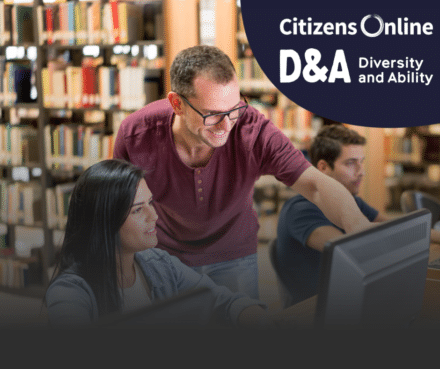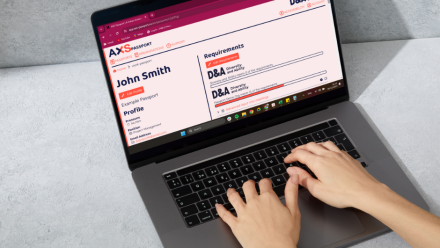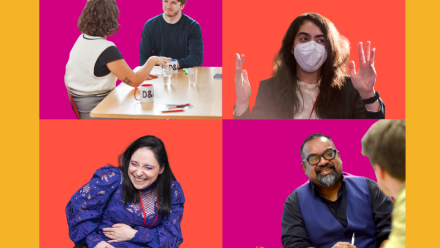Digital Inclusion and Disability: Why we need an intersectional approach
4th December 2023 by Ellie Thompson

This blog was co-written with Ellen Martin, Research and Evaluation Officer at Citizens Online
Digital Inclusion and Disability: Why we need an intersectional approach
Disabled people are 35% less likely to have essential digital skills for life. [1] Those with lower incomes, older people, and disabled people are all at a higher risk of being digitally excluded. Yes, anyone can be digitally excluded. Digital exclusion is not the result of one factor, but many:
- The design of digital services and how accessible they are for people with different disabilities
- How disability and digital inclusion intersects, or overlaps, with other social categories. Such as race, sexuality, gender, social class, and more.
Intersectionality explains how different social categories interact with one another. These interactions produce unique positions of discrimination and/or privilege.[2] For example, a person using a wheelchair may be able to use a website that a person with a visual impairment cannot. Another example is that a black wheelchair user may experience a unique form of discrimination rooted in both ableism and racism, compared to that of a white wheelchair user. Intersectionality tells us that there is not a hierarchy of discrimination. Instead, it offers a way to understand how different factors of our identity intersect to produce unique experiences. You can read more about intersectionality on our blog.
Disability and Digital Inclusion
The digital world is not accessible for many reasons. For disabled people, there are additional barriers created through poor design. Research from Reason Digital shows that the most common barriers are:
-
The content is not clear
Instead, content should be clearly organised, easy to read, and avoids complex language.
-
Information is not easy to see
The text should be the right font and colour that is easier to read. This is especially important for blind and partially sighted people, and neurodiverse people
-
Websites or apps are not compatible with accessibility software [3]
Accessibility software, supports people who experience visual, hearing, motor, or cognitive impairments. It is a vital resource for removing the exclusionary barriers that many disabled users face when accessing a website. Examples are:
- Screen-reader software, which can read out the text and image descriptions from each page.
- Magnifying software, which zooms in on specific aspects of a page.
- Screen veils, which change the colours of a page.
“When a website isn’t compatible with technology, it immediately bars many disabled people from accessing the content. What’s more, it often feels like a signpost for disabled people that the website creators aren’t interested in welcoming us. We’re unlikely to choose to interact with a website which wasn’t accessible to us, which can mean businesses missing out on customers, and services missing out on connecting with the service users who would most benefit from support or engagement.”
This is further proven by the fact that 69% of disabled users will immediately exit a website that they don’t find easy to use. [4]
Public sector bodies have been subject to the Accessibility Regulations since 2018. However, monitoring done in 2020-2021 by the Central Digital & Data Office found accessibility issues on nearly all tested websites. 41% of issues remained after a report and retest.[5]
Improving Websites
Websites and apps become more accessible when:
- The reading age of the text is tested, and text adjusted if needed
- Screen-reader compatibility is checked
- Websites and content is tested with users, or even better co-produced with users
For more guidance, check out Diversity and Ability’s free guide to creating an accessible website.
Having clear and accessible websites is key. However, users need to have the skills, confidence and motivation to use them. Access to devices and connectivity (Wi-Fi/data) are also key.
Disability and Other Identities
Disabled people are less likely to be in environments where digital skills are developed. These include formal learning environments [6], further education [7], and the workplace [8]. These are key environments where digital skills can be learnt and improved upon, and for some, offer access to devices and data.
Not all disabled people experience digital exclusion the same. For example, gender intersects with disability to further digitally excluded people. All disabled people will face access and inclusion barriers. However, disabled women will face a ‘double whammy’ of gender and disability discrimination. For example, when searching for work, they are at risk of both a gender and disability pay gap.[9] Research shows that disabled women are more economically marginalised than both disabled men and non-disabled women.[10] Disabled women may therefore face economic barriers when buying devices and connectivity.
The intersection of race with disability further compounds and exacerbates exclusion. Research in 2023 identified people from racially minoritised backgrounds with learning difficulties had a life expectancy of 34 years. This is almost half of the expectancy of 64 for their white counterparts.[11]
This demonstrates that experiences of race and disability can intersect to deepen exclusion. Racially minoritised people may also experience barriers to employment. In London, the average earnings for ‘ethnic minority’ employees is 21.7% less than white employees).[12] Both disabled people and racially minoritised people are more likely to earn less.
Applying Intersectionality
Understanding how different identities can impact disadvantage is key to digital inclusion work. However, not everyone who fits into these categories is digitally excluded. Some people have the skills and just need access to a device. Or, others may have the money for a device, but need the digital support to use it.
Intersectionality also enables us to understand that people need different support. For example, a disabled woman who has English as a Second Language will need specific support. It may be that a disability organisation cannot support her language needs. Or that an organisation that can teach her in her native language, does not meet her accessibility needs.
Poverty and disability: A vicious cycle
Being digitally included comes at a financial cost. Devices, broadband, and phone contracts all cost money. Research predicts that the price of connectivity is only going to rise.
Between 2021-22, 33% of families in London that included a disabled person were in poverty. This is compared to 22% of those without a disabled household member. [13]
The Cost-of-Living Crisis has further widened the gap and exacerbated the damage it causes. Recent research shows that for households with an annual income of under £25,000, 1 in 5 households had no access to the internet. This increased to nearly 33% for disabled people in the same income bracket, and nearly 50% for those over 65%.[14]
The intersection between poverty, disability and digital exclusion creates a vicious cycle of complex and perpetuating barriers. Not being able to confidently and safely go online, limits access to health and social care. [15] Examples include accessing financial support, booking community activities and accessing specialised equipment. Without being able to access support, people become even more excluded.
It’s predicted to cost an extra £975 a month for disabled people to have the same standard of living.[16] This means that connectivity and devices may not be as affordable. Specialised equipment needed to use devices cost extra. But even with access to devices, connectivity, and skills, websites that don’t meet accessibility standards create a further barrier. The impact of disabled people not having equitable access to online platforms and resources can be devastating. For example:
- Disabled people miss out on online healthcare appointments and support. This leads to worsening symptoms or not receiving crucial medication and treatment.
- Disabled people can’t access governmental support. For example, Personal Independence Payment and Universal Credit. Furthering financial exclusion.
- Disabled people can’t access support from charities and not-for-profit organisations. So they miss out on everything from legal advocacy to fulfilment of their basic needs (i.e., information about local food banks).
How can we work to combat digital exclusion?
Atif Choudhury, CEO of Diversity and Ability, highlights that the conversation is rarely about access; it’s about choices:
“Inclusion means acknowledging who, historically, hasn’t been given the choice of participation. Giving people a digital device, or a WiFi connection, will never be enough.”
Physical provisions need to be the final step of a process that starts with:
- Systemic changes to inclusion practices, both online and offline
- Digital accessibility that, at a bare minimum, meets the public sector accessibility regulations
- Supporting training and coaching to ensure digital skills become a sustained part of practice
Free Online Resource: AXS Passport
Diversity and Ability’s digital AXS Passport provides a tool for individuals to share their access and inclusion needs. You can do this whilst maintaining control of their personal information.
The AXS Passport is free for individual users. Diversity and Ability host regular events to demonstrate how a user can create use the passport. This includes how to create their AXS Passport, add their requirements, and discover a more efficient and supportive way to share what they need to participate and thrive across all areas of life.
D&A is also working with organisations across the globe to embed AXS Passport in their supportive systems.
Citizens Online Phone Line
If you, or someone you know, need help with basic digital skills or support getting online,. You can call Citizens Online’s free helpline: 0808 196 5883 and leave a message. One of their team of trained digital champions will ring you back and offer friendly, patient support over the phone.
Citizens Online have also collected a list local digital inclusion networks. These networks compile lists of local support. You can see if there is one near you on their website.
Also on their website are their projects where they are offering in person support.
[1] Lloyds Bank, UK Consumer Digital Index, 2019
[2] Coined by Kimberlé Crenshaw, intersectionality acknowledges that everyone has their own unique experiences of discrimination and oppression. For example, it is likely a disabled man will experience ableism differently to a disabled woman, as she will hav e the compounded impact of ableism and sexism, whilst recognising that two disabled women will have very different experiences.
[3] Reason Digital, Radical Accessibility: Research and Recommendations, July 2020.
[4] Freeney Williams Limited, The Click-Away Pound Report, February 2020
[5] Central Digital & Data Office, Corporate Report: Accessibility monitoring of public sector websites and mobile apps, Dec 2021.
[6] Office for National Statistics, Outcomes for disabled people in the UK: 2021, February 2022
[7] UK Parliament, Support for disabled students in Higher Education in England, February 2021
[8] UK Parliament, Disabled people in employment, June 2023.
[9] Caroline Walters, “The ‘double whammy’ of being a disabled woman in the UK”, Equality and Human Rights Commission.
[10] Eun Jung Kim, “The impact of gender and disability on the economic well-being of disabled women in the United Kingdom: A longitudinal study between 2009 and 2014”, Social Policy & Administration, Wiley, Volume 53, Issue 7.
[11] Umpleby, K., Roberts, C., Cooper-Moss, N., Chesterton, L., Ditzel, N., Garner, C., Clark, S., Butt, J., Hatton, C., Chauhan, U. We deserve better: Ethnic minorities with a learning disability and barriers to healthcare. Race and Health Observatory Report, 2023.
[12] ONS, Ethnicity pay gaps in Great Britain: 2018.
[13] Trust for London, Poverty and Disability.
[14] Institute of Development Studies, Policy Briefing: Digital Poverty in the UK, August 2022.
[15] NHS Digital, Why digital inclusion matters to health and social care, September 2022
[16] SCOPE, Disability Price Tag 2023: the extra cost of disability, 2023,


